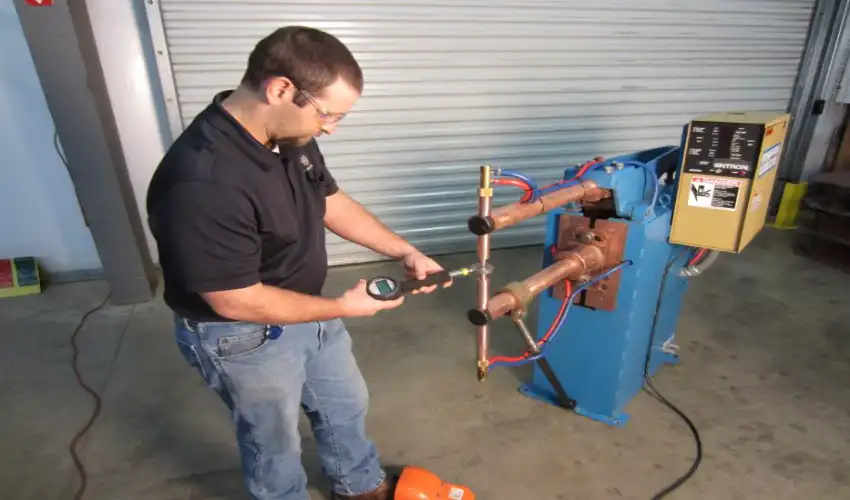Spot welding is an indispensable process in metalworking, providing a quick, efficient, and reliable method to join metal sheets. Whether you are running a professional fabrication shop or managing a personal garage, having the right spot welding machine can dramatically improve the quality and speed of your work. This article explores the essential spot welding machine every metalworker should consider, their key features, and why investing in a high-quality machine is a smart decision.
Why Spot Welding is Crucial for Metalworkers
Spot welding is a form of resistance welding that uses pressure and electric current to join two or more metal sheets at precise points. Unlike other welding techniques, spot welding requires minimal filler material, making it cost-effective and suitable for mass production. It’s particularly popular in the automotive, aerospace, and appliance industries due to its ability to produce strong, clean, and uniform welds.
For metalworkers, spot welding offers several advantages:
- Speed: The process is fast, allowing for multiple welds in a short period.
- Consistency: Provides uniform welds, which is critical for structural integrity.
- Clean Finish: Minimal surface contamination, reducing post-weld finishing time.
- Cost-Effective: Less material and energy are required compared to traditional welding methods.
Types of Spot Welding Machines
When choosing a spot welding machine, understanding the different types available is essential. Each type offers unique benefits tailored to specific metalworking needs.
- Portable Spot Welding Machines
Portable spot welders are lightweight, easy to handle, and ideal for small-scale projects or mobile work environments. These machines are perfect for auto repair shops, DIY enthusiasts, and small metal fabrication tasks. Despite their compact size, they deliver sufficient power for thin metal sheets and provide precise welds. - Bench-Top Spot Welding Machines
Bench-top welders are designed for workshops with limited space. They sit on a workbench, offering stability and consistent welds. These machines typically feature adjustable current settings, allowing operators to handle a variety of metal thicknesses. They are well-suited for repetitive tasks such as assembling electrical enclosures, metal cabinets, and sheet metal components. - Pedestal Spot Welding Machines
Pedestal models are larger, floor-standing units built for heavy-duty applications. These machines handle thicker metals and larger production volumes. With advanced features like timed welding cycles and automated pressure control, pedestal spot welders are ideal for industrial fabrication shops and automotive manufacturing plants. - Capacitor Discharge Spot Welders
Capacitor discharge welders use stored energy to deliver short, high-intensity pulses of current. These machines are excellent for precision applications, such as welding small metal parts or thin foils. They minimize heat distortion, making them perfect for delicate projects and intricate metal assemblies.
Key Features to Consider
Selecting the right spot welding machine goes beyond type; several critical features can enhance performance and ensure durability:
- Adjustable Current Settings: Different metals and thicknesses require varying current levels. Machines with adjustable settings allow precise control over the weld strength.
- Electrode Material and Size: Copper electrodes are standard for their excellent conductivity. The size and shape of electrodes also impact weld quality.
- Pressure Control: Proper pressure ensures strong and consistent welds. Look for machines with adjustable pressure mechanisms for versatility.
- Cooling Systems: Efficient cooling, often via water or air, prevents overheating during prolonged use, extending the machine’s lifespan.
- Automation and Timers: Advanced models include programmable timers and automated cycles, improving accuracy and reducing operator fatigue.
Benefits of Investing in a Quality Spot Welding Machine
Investing in a high-quality spot welding machine pays off in multiple ways:
- Enhanced Productivity: Efficient machines complete welds faster, reducing labor time and increasing output.
- Improved Safety: Modern machines include safety features such as overload protection and insulated electrodes, reducing the risk of accidents.
- Consistency and Reliability: A reliable machine ensures uniform welds, which is crucial for maintaining product quality and structural integrity.
- Long-Term Savings: While high-end machines may have a higher upfront cost, their durability, energy efficiency, and reduced maintenance requirements save money over time.
Tips for Maintaining Your Spot Welding Machine
To maximize the lifespan and performance of your spot welder, proper maintenance is essential:
- Regular Cleaning: Keep electrodes and machine surfaces free from metal debris and oxidation.
- Check Connections: Ensure all electrical connections are tight and corrosion-free.
- Inspect Electrodes: Replace worn or deformed electrodes to maintain consistent weld quality.
- Lubricate Moving Parts: Prevent wear and tear on mechanical components by following manufacturer-recommended lubrication schedules.
- Follow Manufacturer Guidelines: Adhering to the operating instructions ensures safe and efficient machine operation.
Conclusion
Spot welding machines are indispensable tools for metalworkers of all levels. From portable units for DIY projects to heavy-duty pedestal machines for industrial fabrication, choosing the right spot welder is key to achieving professional-grade results. By considering factors such as machine type, features, and maintenance requirements, metalworkers can enhance efficiency, ensure consistent weld quality, and enjoy long-term savings. Investing in a reliable spot welding machine is not just a purchase—it’s a commitment to precision, durability, and professional excellence in every metalworking project.
